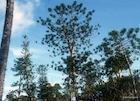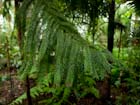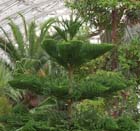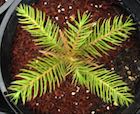Conservation Status

Araucaria nemorosa
de Laub. 1969
Common names
Boise araucaria (Silba 1986).
Taxonomic notes
Synonym: Eutassa nemorosa (de Laub.) de Laub. 2009. A molecular analysis places Araucaria nemorosa into the clade of coastal species of New Caledonia, along with A. columnaris and A. luxurians (Gaudeul et al. 2012). A concise summary of the species' taxonomy is provided by Waters et al. (2002), pages 11-12. I recommend reading this short piece now, if you're interested; it is available online HERE. Waters et al. (2002) also report that a person named Bernard Suprin has reported a single tree near Port Boise that appears to be a hybrid of Araucaria columnaris and A. nemorosa, with pollen cones resembling those of A. nemorosa but foliage resembling that of A. columnaris.
Description
Monoecious evergreen trees to 15 m tall, with an oval or conical crown. Twigs 8-12 mm in diameter. Juvenile leaves needle-like, lanceolate, curved inwards, relatively thick. Adult leaves imbricate, lanceolate, narrow, scale-like, midrib prominent, keeled dorsally, 6-10 × 1.5-3 mm, apex bluntly acute and incurved. Pollen cones cylindrical, 8 cm long by 14 mm wide, microsporophylls triangular, pollen sacs 6. Seed cones ovoid, 11 × 5-9 cm, with reflexed bracts 12-20 mm long. Seeds to 30 mm long, nut somewhat rectangular, wings broadly ovate. Cotyledons 4, germination epigeal (Silba 1986).
Distribution and Ecology
New Caledonia. According to Waters et al. (2002): "Araucaria nemorosa is known onIy from the region around Port Boise, south of the Plaine des Lacs, east of the Baie de Prony and southwest of Goro. Although populations have been reported from a number of sites between Cap Ndoua and Cap Reine Charlotte, almost all of these (with the exception of one tiny inland population ...), are in coastal forest less than 2 km inland (usually less than 1 km inland) and at altitudes less than 100 m (usually less than 20 m) above sea-leveI. Annual rainfall in the Port Boise area is approximately 2500-3000 mm (ORSTOM 1981); soils and underlying rocks in the Port Boise area, are impoverished indurated ferritic soils overlying peridotites, as throughout the southern part of Grande Terre (ORSTOM 1981). The coastal forest at Port Boise has been characterized as low altitude dense evergreen forest (Morat et al. 1981), and the angiosperm trees within it form a canopy at a height of c. 10 m. The coastal rocks and adjacent cliffs support an extremely narrow (<10m wide) and extremely dense population of Araucaria columnaris, a formation described by Jaffre (1995) and first noted in 1774 (Hoare 1982). As well as coastal forest and isolated human settlement, there are extensive areas of scrub on black Iaterized rock (known as cuirasse (Enright and Goldblum 1998)) c. 1m to 1.5m high, often dominated by Baeckea ericoides Schlect. These areas are typically slightly further inland than the forest and possibly represent secondary vegetation after deforestation or fire, although there is no evidence of either forest exploitation or a history of recent fire. This comparatively depauperate formation blends into typical maquis sensu Morat et al. (1981), which is slightly higher (c. 2 m or more) and with abundant Gymnostoma L.A.S. Johnson. Occasional stands of the common New Caledonian tree Melaleuca quinquenervia are also present, with thick deposits of fallen leaves and little or no understorey." Waters et al. (2002) also present a demographic study of three of the eight known populations of the species.
This maps shows herbarium records of Araucaria species native to New Caledonia. Letter corresponds to first letter of species epithet (A. goroensis coded as A. muelleri, see A. goroensis for discussion). Click on an icon for further information. Distribution data from GBIF (2020.03.30), edited to remove duplicates.
The IUCN reports that this species is facing an extremely high risk of extinction in the wild due to a limited, severely fragmented range with ongoing decline in both extent of habitat and size of populations.
Remarkable Specimens
The largest tree found by Waters et al. (2002) was 65 to 70 cm dbh. The only available age estimates are from the demographic work by Waters et al. (2002); they used extrapolated growth rates to estimate that the oldest trees in their study were about 80 years old.
Ethnobotany
Waters et al. (2002) described a dendrochronological study in which they took 21 samples and found that they contained up to about 150 rings. However, they had doubts that the rings are produced annually.
Observations
No data as of 2023.02.22.
Remarks
The epithet nemorosa means "wooded", as a forest.
Citations
Hoare, M.E. (ed.). 1982. The Resolution Journal of Johann Reinhold Forster 1772-1775. 4 vols. London: The Hakluyt Society.
Gaudeul, M., G. Rouhan, M.F. Gardner, and P.M. Hollingsworth. 2012. AFLP markers provide insights into the evolutionary relationships and diversification of New Caledonian Araucaria species (Araucariaceae). American Journal of Botany 99(1):68-81.
Jaffré, T. 1995. Distribution and ecology of the conifers of New Caledonia. Pages 171-196 in Neal J. Enright and Robert S. Hill (eds.), Ecology of the Southern Conifers. Washington, DC: Smithsonian Institution Press.
Laubenfels, D.J. de. 1969. Trav. Lab. Forest. Toulouse 1, 8(5):2.
Morat, P., Jaffre, T., Veillon, J.M., and MacKee, H.S. 1981. Vegetation. In ORSTOM. Atlas de Nouvelle-Caledonie et Dependances. Office de la Recherche Scientifique et Technique Outre-Mer, Paris.
ORSTOM. 1981. Atlas de Nouvelle-Caledonie et Dependances. Office de la Recherche Scientifique et Technique Outre-Mer, Paris.
Waters, T., C.A. Galley, R. Palmer, S.T. Turvey, and N.M. Wilkinson. 2002. Report of the Oxford University Expedition to New Caledonia. Oxford University.
See also
Association Endemia, a site devoted to New Caledonian species. Has excellent photos, a range map, and other information. In French.
The species account at Threatened Conifers of the World.





